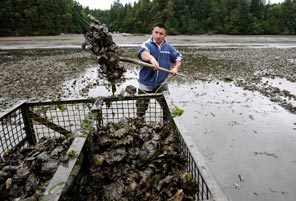Posted on Seattle Times: 27 Nov 2012 — By Craig Welsh — A panel appointed by Gov. Chris Gregoire made dozens of recommendations for tackling the rising acidity in Northwest marine waters, which already has upended the West Coast’s multimillion-dollar shellfish industry and threatens to wreak havoc on the region’s marine food web

Efrain Rivera uses a pitchfork to harvest Pacific oysters at low tide at a Taylor Shellfish farm in Oyster Bay near Olympia. Such oyster farms are the earliest victims of ocean acidification as souring waters already have made it difficult for some shellf
To combat ocean acidification in Washington, the state needs to better track the changing chemistry of Puget Sound, reduce stormwater runoff and nutrient pollution that worsen the problem, and counteract souring waters by sprinkling shells in estuaries or growing more carbon-gobbling vegetation.
But above all, the state must advocate for regional, national and international policies to reduce carbon-dioxide emissions, according to authors of a first-of-its-kind report released Tuesday about the changing chemistry of Washington’s marine waters.
The group of policymakers and scientists appointed by Gov. Chris Gregoire made dozens of recommendations for tackling the rising acidity in Northwest marine waters, which already has upended the West Coast’s multimillion-dollar shellfish industry and threatens to wreak havoc on the region’s marine food web if chemical changes continue unabated.
From urging state leaders to find “refuges” for some of the 30 percent of Puget Sound organisms that appear susceptible to increasingly corrosive water, to seeking ways to help species adapt to marine changes already under way, the panel outlined a complex attack on a problem that is at once regional and global.
“Nowhere on our planet is a local response more urgently needed than here in Washington,” said Jane Lubchenco, administrator of the National Oceanic and Atmospheric Administration, who was on hand for the report’s unveiling at the Seattle Aquarium.
Gregoire responded on Tuesday by signing an executive order urging the state to take the panel’s recommendations. She also is putting $3.3 million in her last budget proposal to help shellfish hatcheries maintain equipment for monitoring acidic water, help create an ocean-acidification center at the University of Washington to study the impact on marine life and begin reducing water pollution.
The money would come from hazardous-waste taxes and geoduck harvest leases.
Meanwhile, state Sen. Kevin Ranker, D-Orcas Island, said he planned to introduce bills during the next legislative session that would allow communities to bypass restrictions in the Growth Management Act, in limited areas, that prevent them from extending sewage treatment to places where septic systems could fail and pollute marine waters.
No other state has attempted to respond officially on its own to ocean acidification.
At issue is how to respond to the falling pH of the state’s marine waters as oceans take up carbon dioxide dumped into the atmosphere by the burning of fossil fuels.
By at least tackling local pollution sources, such as nitrates from sewage or livestock and runoff from cities and forests, the state could make headway while national and international leaders debate what to do about carbon-dioxide emissions, according to the panel.
“We don’t have a precise understanding of how big a role local sources play, and it’s different in different locations,” said Jay Manning, Gregoire’s former chief of staff and co-chair of the panel. “But I suspect we’ll find their contributions (to acidification) are quite significant.”
What’s clear is that while scientists predicted acidification would harm marine creatures in coming decades, it’s actually doing so now.
Since 2005, wild and hatchery-grown oysters have struggled to reproduce in Washington waters. Scientists this year finally showed that was directly linked to more corrosive waters that killed oyster larvae.
Just this week, researchers showed that tiny snaillike pteropods that feed fish around the globe are being damaged off the coast of South America in waters less sour than those in Washington.
“We simply cannot sit idly by while this happens,” said Manning’s co-chairman Bill Ruckelshaus, former administrator of the Environmental Protection Agency under Presidents Nixon and Reagan.
Particularly hard hit by rising acidity are creatures that rely on calcium carbonate to build shells or other bodily structures — everything from clams and mussels to many fish.
That’s why federal and university scientists in Seattle and the San Juan Islands are studying carbon dioxide’s effect on everything from Dungeness crab and geoduck to rockfish and tiny sea snails.
And that’s also why the panel recommended exploring places where calcium-carbonate-rich shells could be tossed in shallow waters to combat souring seas.
But because the changes are taking place so fast — and because it’s difficult and expensive to track them in a complex environment like Puget Sound or the Washington Coast — it’s not clear what other creatures or marine functions might be undergoing stress or change.
So much of the panel’s work called for more research.
“We now need to have a better understanding of how the changes are taking place at the very bases of the food chain and how those changes permeate through the food chain up to fish and birds and mammals,” Feely said.
Scientists are only beginning to understand just how the food web will respond as changes hit some predators and prey but not others.
“When it comes to ocean acidification, we’re all still explorers,” said Lubchenco.
Craig Welch: 206-464-2093 or cwelch@seattletimes.com. On Twitter @craigawelch.
Read this story on Seattle Times.